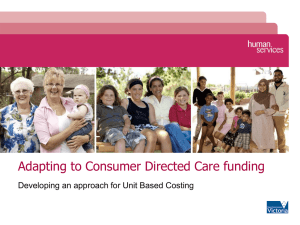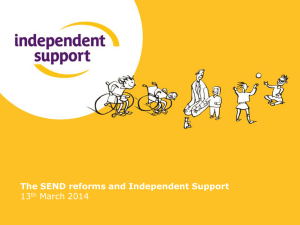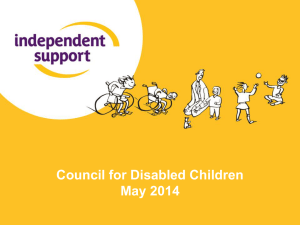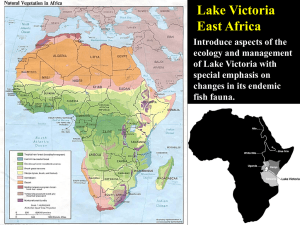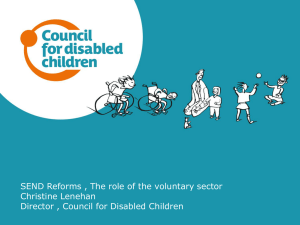Leadership Victoria - Department of Human Services
advertisement
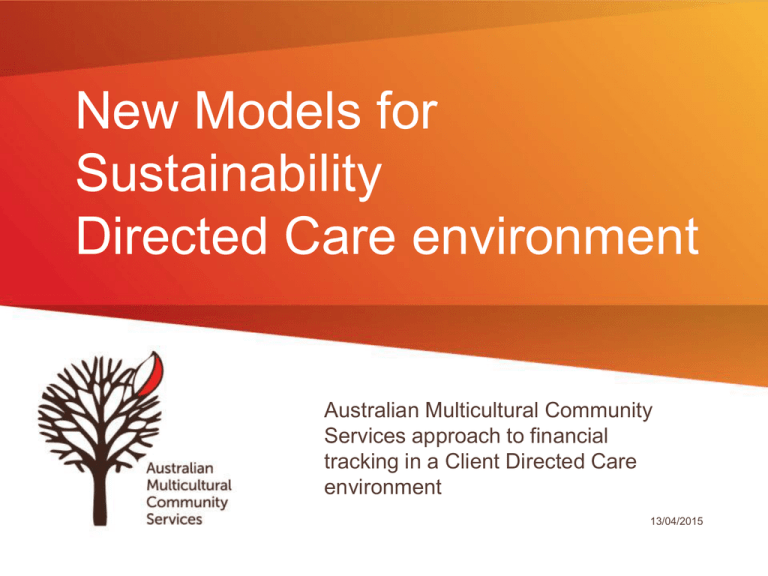
New Models for Sustainability Directed Care environment Australian Multicultural Community Services approach to financial tracking in a Client Directed Care environment 13/04/2015 Consumer Directed Care (CDC) – Strategies for success A tracking system that will measure viability in providing CDC services with a whole of organisational approach. 13/04/2015 Produced and funded Australian Multicultural Community Services Inc. (producer) Department of Human Services – Victoria (funder) The Building Community Sector Capacity to Adapt to a New Funding Environment project was supported by the Victorian Government 3 About AMCS AMCS is a community based organisation addressing the diverse and changing needs of multicultural communities in Victoria. We are caring for, supporting and educating Victoria’s multicultural communities, families and individuals to reach their full potential. We work with people of all cultures, faiths and genders to achieve cultural diversity, equity and consumer satisfaction. We care, we support, we educate. 4 The project Project background AMCS and Leadership Victoria Costing model, Training program & Tool Project outcomes Key learning and applicability to other organisations Conclusion 5 Project Background Not-for-profit organisations are now adapting to a raft of government reforms that have been influenced by changing policy objectives, including: The introduction of the first stage of the National Disability Insurance Scheme and the roll-out of pilot projects. The One DHS policy and funding plan. The award modernisation process. The commencement of the Consumer Directed Care (CDC) funding and care model for community aged care programs. Office for the Community Sector was approached to support the project as an example of how community sector capacity could be enhanced through partnerships Key themes across the current Victorian and national reform agenda include a focus on service delivery based on individual choice and purchase. 6 AMCS and Leadership Victoria Leadership Victoria is a not-for-profit organisation that aims to develop outstanding leaders who can create positive change within a global community. GreatConnections is a program that links experienced professional volunteers with the needs of not-for-profit organisations in areas such as business planning, governance, strategic planning and marketing. AMCS approached Leadership Victoria to provide pro bono business mentoring through GreatConnections. In turn this enabled Leadership Victoria to investigate the level of support required in the businessplanning sphere. Leadership Victoria recommended a suitably qualified volunteer to undertake a review of AMCS’s readiness to operate under a CDC model and build their capacity to develop and implement a unit-based costing model. 7 Costing Model, Training Program and Tool Expenses are allocated to programs either: Directly including the cost of care and wages (plus on-costs) incurred and an hourly rate calculated for care workers and case managers. Recording centrally and allocated based on the resources intensity of the program; includes direct labour, administration and general overheads. In addition, an organisation needs to include an appropriate margin to ensure their sustainability. This can be included in two ways: Direct labour hourly rate and the overhead recovery rate OR Separately identified on the client’s budget and recorded as a line. How the margin is included depends on the degree of transparency an organisation wishes to adopt with their clients. There are arguments to support both ways: the labour rate allows easy comparison to brokerage rates charged by external clients; the overhead rate is consistent with the concept of a margin on costs, such as labour. Or they can be separately identified for transparency reasons. A tool (in Excel) has been developed to assist providers to determine hourly and overhead recovery rates. This model identifies the margin separately. 8 The Components of the CDC Tool Consumers Individual Budgets - "ledger" Income Cost Allocations Reporting Mechanisms Matching Mechanisms I – Income E – Expenses R – Reporting M - Matching 9 Consumers Individual Budgets - "ledger“ Step 1: Step 2: Step 3: Step 4: Step 5: Set up a "ledger" account for each consumer As funds are received that relate to the consumer then these are allocated against the consumers "ledger" account As the costs of their care is expended then this cost will be allocated against the consumers "ledger" account Each month the income and expenses will be balanced to determine and over or under expenditure of funds to the individual consumer "ledger" accounts Each month these consumer "ledger" accounts will need to be reviewed and consideration given to whether any adjustments are required as the result of over or under expenditure 10 Consumers Individual Budgets - "ledger“ Step 6: Any surplus funds are to be kept in the consumers "ledger" account, while any over expenditure will have to be negotiated with the consumer in relation to cutting back future costs Step 7: In the provider is unable to make any cut backs to the individual consumer, then the provider will have to carry the costs Step 8: These "ledger" accounts will provide the monthly statement for the consumers, with the attachments of expenditure, if required 11 Exercises in CDC Income Administration Core Advisory Services Direct Services Matching 12 Project Outcomes As part of preparing AMCS to be CDC-ready, financial reporting was improved to ensure indirect program costs were allocated on an appropriate basis. A suitable costing model has also been identified and trialled. The Leadership Victoria volunteer program is an excellent way for not-for-profit organisations to access skilled assistance with projects on a pro bono basis that otherwise would be beyond their capacity. Following a project trial and analysis, and consultations with several community aged care organisations, the following Consumer Directed Care (CDC) financial approach can be considered for use by other organisations: 13 Key Learning and applicability to other organisations Community sector organisations impacted by the introduction of the CDC model need to build internal capacity to adjust to the operational and financial changes required as a result of the new policy and funding model. Leadership Victoria is one organisation which can enhance the capacity of not- for-profit organisations to adapt to the new policy and funding environment by providing specialist volunteer support in areas such as business planning, governance, strategic planning and marketing. Appropriate financial recording systems need to be in place and all relevant staff need to be cognisant of the overall cost of providing home aged care, both in the main financial system and the care management system. Regular review of levels of care provided is required to ensure clients are not receiving care above the funding received. This review should encompass both care levels and available funding. It is important to acknowledge that the introduction of a CDC model will also require significant cultural change as staff adapt to a new model of operating which requires an increased level of attention to “costing” the various activities they undertake. 14 Conclusion The Building Community Sector Capacity to Adapt to a New Funding Environment project has identified the extent of systems and cultural changes community service providers will need to implement to ensure adherence to new government funding guidelines and to ensure financial sustainability. The CDC tool and training program has been developed to assist organisations to become CDC-ready. This resource is now available for use by other community organisations. The project has also highlighted the benefits of partnership with other NFP organisations, such as Leadership Victoria, regarding unit costing and change management. Thank you 15
